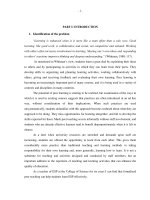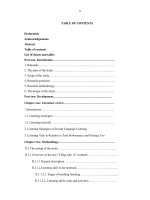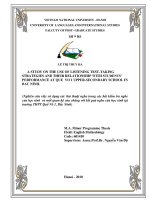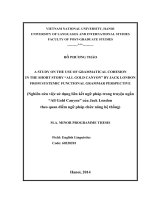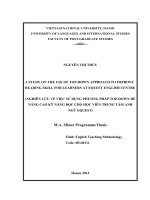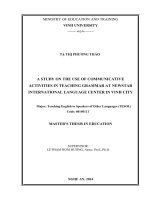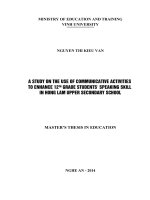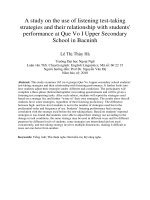A study on the use of mobile language learning applications adopted by second year english majors at vietnam national university of agriculture
Bạn đang xem bản rút gọn của tài liệu. Xem và tải ngay bản đầy đủ của tài liệu tại đây (584.39 KB, 56 trang )
VIET NAM NATIONAL UNIVERSITY OF AGRICULTURE
FACULTY OF EDUCATION AND FOREIGN LANGUAGES
BA THESIS
A STUDY ON THE USE OF MOBILE LANGUAGE
LEARNING APPLICATIONS ADOPTED BY SECONDYEAR ENGLISH MAJORS AT VIETNAM NATIONAL
UNIVERSITY OF AGRICULTURE
NGHIÊN CỨU VỀ VIỆC SỬ DỤNG CÁC ỨNG DỤNG
HỌC NGOẠI NGỮ TRÊN THIẾT BỊ DI ĐỘNG CỦA
SINH VIÊN NĂM THỨ HAI NGÀNH NGÔN NGỮ ANH
TẠI HỌC VIỆN NÔNG NGHIỆP VIỆT NAM
Student
: LE THI AN
Student code
: 621212
Major
: ENGLISH
Supervisor
: NGUYEN THI HOAI, M.A.
Hanoi – 2021
VIET NAM NATIONAL UNIVERSITY OF AGRICULTURE
FACULTY OF EDUCATION AND FOREIGN LANGUAGES
BA THESIS
A STUDY ON THE USE OF MOBILE LANGUAGE
LEARNING APPLICATIONS ADOPTED BY SECONDYEAR ENGLISH MAJORS AT VIETNAM NATIONAL
UNIVERSITY OF AGRICULTURE
NGHIÊN CỨU VỀ VIỆC SỬ DỤNG CÁC ỨNG DỤNG
HỌC NGOẠI NGỮ TRÊN THIẾT BỊ DI ĐỘNG CỦA
SINH VIÊN NĂM THỨ HAI NGÀNH NGÔN NGỮ ANH
TẠI HỌC VIỆN NÔNG NGHIỆP VIỆT NAM
Student
: LE THI AN
Student code
: 621212
Major
: ENGLISH
Supervisor
: NGUYEN THI HOAI, M.A.
Hanoi – 2021
ACKNOWLEDGEMENT
In order to complete the graduation thesis with the topic " A study on the
use of mobile language learning applications adopted by second – year English
majors at Vietnam National University of Agriculture
”, besides my own
constant efforts, I have received a lot of attention and support from teachers,
family and friends.
I would like to express my sincerest thanks to the teachers in the Faculty
of Education and Foreign Languages, Vietnam National University of
Agriculture. In particular, I would like to express my sincerest and deepest
thanks to M.A. Nguyen Thi Hoai for her enthusiastic guidance and support
during the process of completing my graduation thesis.
I would like to thank my family and friends who always encouraged and
helped me when I faced some difficulties.
During the process of doing my graduation thesis, I feel that I have
learned and experienced many useful things. From there, let me learn and draw
experience for my future working process.
My thesis will not be able to avoid limitations and shortcomings. I look
forward to receiving comments and suggestions from teachers and classmates to
help improve the thesis.
i
CERTIFICATE OF ORIGINALITY
I, the undersigned, hereby certify my authority of the study project report
entitled A study on the use of mobile language learning applications adopted
by second – year English majors at Vietnam National University of
Agriculture submitted in partial fulfillment of the requirements for the degree
of Bachelor in English Language. Except where the reference is indicated, no
other person‟s work has been used without due acknowledgement in the text of
the thesis.
Hanoi, 2021
Le Thi An
Approved by
SUPERVISOR
(Signature and full name)
Date:……………………
ii
TABLE OF CONTENTS
ACKNOWLEDGEMENT ..................................................................................... i
CERTIFICATE OF ORIGINALITY .................................................................... ii
TABLE OF CONTENTS ..................................................................................... iii
ABSTRACT .......................................................................................................... v
LIST OF ABBREVIATION ................................................................................ vi
LIST OF TABLES AND FIGURES ................................................................... vii
Part I: INTRODUCTION ................................................................................. 1
1.1. RATIONALE FOR THE STUDY ................................................................. 1
1.2. AIMS AND OBJECTIVES OF THE STUDY .............................................. 2
1.3. RESEARCH QUESTION .............................................................................. 2
1.4. SCOPE OF THE STUDY .............................................................................. 2
1.5. SIGNIFICANCE OF THE STUDY ............................................................... 5
1.6. DESIGN OF THE STUDY ............................................................................ 5
Part II: DEVELOPMENT ................................................................................. 7
Chapter I: LITERATURE REVIEW ............................................................... 7
1.1. THE CONCEPT OF MOBILE LEARNING ................................................. 7
1.2. LEARNING THEORIES IN RELATION TO MOBILE LEARNING ........ 9
1.3. FEATURES OF MOBILE LANGUAGE LEARNING .............................. 10
1.4. PREVIOUS STUDIES ................................................................................. 12
1.5. SUMMARY ................................................................................................. 13
Chapter II: METHODOLOGY ....................................................................... 14
2.1. RESEARCH GOVERNING ORIENTATION ............................................ 14
2.2. RESEARCH METHODS............................................................................ 14
2.2.1. Research context ....................................................................................... 14
2.2.2. Data collecting procedures ........................................................................ 14
2.2.3. Description of the questionnaire ............................................................... 15
2.2.4. Description of the interview questions...................................................... 16
iii
2.2.5. Data analysis ............................................................................................. 16
2.3 SUMMARY .................................................................................................. 18
Chapter III: FINDINGS AND DISCUSSION ................................................ 19
3.1. RESEARCH QUESTION 1: TO WHAT EXTENT DO SECOND-YEAR
ENGLISH MAJORS AT VNUA USE FOREIGN LANGUAGE LEARNING
APPS? .................................................................................................................. 19
3.1.1. General situation of using foreign language learning applications on
mobile devices. .................................................................................................... 19
3.1.2. The Frequency of using foreign language learning applications on mobile
devices ................................................................................................................. 20
3.2. RESEARCH QUESTION 2: TO WHAT EXTENT DO SECOND-YEAR
ENGLISH MAJORS AT VNUA USE DIFFERENT FEATURES OF MOBILE
LANGUAGE LEARNING APPLICATIONS? .................................................. 24
3.3. RESEARCH QUESTION 3 : WHAT ARE THE MOST COMMON
REASONS WHY SECOND-YEAR ENGLISH MAJORS AT VNUA USE
MOBILE LANGUAGE LEARNING APPS? .................................................... 26
3.4. RESEARCH QUESTION 4: WHAT ARE STUDENTS‟ SUGGESTIONS
FOR EFFECTIVE USE OF MOBILE LANGUAGE LEARNING APPS?....... 28
3.5. DISCUSTION .............................................................................................. 29
3.6. SUMMARY ................................................................................................. 31
Part III: CONCLUSION .................................................................................. 32
1. Recapitulation................................................................................................. 32
2. Concluding remarks ........................................................................................ 32
3. Limitations of the study .................................................................................. 32
4. Recommendations/ Suggestions for further study .......................................... 33
REFERENCES .................................................................................................. 34
Appendix 1 ......................................................................................................... 37
Appendix 2 ......................................................................................................... 46
iv
ABSTRACT
This study investigate the student's usage of differnt apps., how often the
apps is used, and what Suggestions are there for more effectiveness of mobile
learning apps for English learning. The survey consisted of closed-ended and
open-ended questions and was analyzed using descriptive statistics. In addition,
the researcher conducts interviews so that the report is authentic and trustworthy.
This study investigates students' use of different apps, how often they use the
apps, and what recommendations are there for making mobile English learning
apps more effective. The survey consisted of closed-ended and open-ended
questions and was analyzed using descriptive statistics. In addition, the
researcher conducts the interviews so that the report is authentic and reliable.
The results show that the majority of students use Tflat and Oxford dictionary
applications for the purpose of developing vocabulary knowledge. Using a
combination of multiple applications is more efficient than using only one. In
addition, a clear study plan is essential for students.
v
LIST OF ABBREVIATION
VNUA
: Vietnam National University of Agriculture
Apps
: applications
M
: Mean
SD
: Standard deviation
vi
LIST OF TABLES AND FIGURES
Table 1.1: Participants‟ classes ............................................................................. 3
Table 1.2: Genders ................................................................................................ 4
Table 1.3: English proficiency levels .................................................................... 4
Table 3.1: Popular mobile language learning apps among the students ............. 21
Table 3.2: Some less popular applications .......................................................... 23
Table 3.3: Features of mobile applications ......................................................... 25
Table 3.4: Reasons for using ............................................................................... 27
Figure 1: The frequency of using foreign language learning apps on mobile
devices ................................................................................................................. 19
vii
Part I: INTRODUCTION
1.1. RATIONALE FOR THE STUDY
We have entered the Technology 4.0 era. With the widespread popularity
of phones, computers, and mobile devices now in our pockets, connecting to
various information sources and communicating with anyone at any time and
from anywhere has become very easy. For teachers, they can innovate their
teaching methods so that students are interested in learning. For students, they
can adjust their learning methods to improve their English level. Because of the
mobility, availability, and flexibility of these devices, students can study at any
time and from any location, even if they do not have access to computers or
study materials. As a result, a more personalized and learner-centered
experience is possible. Mobile devices give users control over content and pace,
which makes them appealing to people who want to take control of their own
learning by setting goals and taking the initiative to plan learning activities.
Furthermore, mobile devices can strengthen user connections, create favorable
conditions for everyone to exchange and learn from each other‟s knowledge and
experience. A mobile application is a piece of software designed to run on
mobile devices such as smartphones and tablets. They transform them into minienvironments for study, entertainment, shopping, etc. Foreign language learning
apps entail learning, cultivating, and practicing languages. A large number of
learning applications are designed and developed as a result of the need to
integrate into the community. According to Jolin (2017), the Apple App Store
alone contains more than 350 language-related apps, including TFLAT,
DUOLINGO, MEMRISE, OXFORD DICTIONARY, etc.
Most lecturers at Vietnam National University of Agriculture have
directed their students to use technology to learn English to make their learning
easier and to save time. Also, due to the current complicated situation of the
Covid-19 epidemic, students have to study online at home, so the use of
1
technology becomes even more important. In addition, the majority of students
continue to struggle with the four skills of listening, speaking, reading, writing
as well as their limited knowledge of vocabulary, pronunciation, and grammar.
Therefore, I have chosen this research topic to investigate the current use of
mobile apps for learning English at Vietnam National University of Agriculture.
1.2. AIMS AND OBJECTIVES OF THE STUDY
The study aims to investigate how second-year English majors at VNUA
use foreign language learning apps on mobile devices. Specifically, the
researcher was interested in the extent to which students used foreign language
learning apps as well as their use of various features of foreign language apps on
mobile devices. In addition, the research was also conducted to find out the most
common reasons why students use mobile language learning apps. Furthermore,
this study was carried out to find some suggestions when using mobile language
learning apps from a student's perspective.
1.3. RESEARCH QUESTION
Research question 1: To what extent do second-year English majors at
VNUA use foreign language learning apps?
Research question 2: To what extent do second-year English majors at
VNUA use different features of mobile language learning apps?
Research question 3: What are the most common reasons why secondyear English majors at VNUA use mobile language learning apps?
Research question 4: What are students‟ suggestions for effective use of
mobile language learning apps?
1.4. SCOPE OF THE STUDY
The research was conducted at VNUA, the second semester of the school
year 2020 - 2021. Participants of the study were 124 second-year English majors
at VNUA. The researcher applied the convenient sampling strategy. According to
the results, there are 105 questionnaires completed but 7 invalid questionnaires.
2
Therefore, the total number of valid questionnaires collected was 98.
Research is limited to second-year students at VNUA. There are two
reasons why the researcher decided to choose them for the study. First,
university students have reached a certain level of language acquisition based on
their capacity to respond to the survey. To some extent, most second-year
students majoring in English have to study many specialized subjects such as
Semantics, Phonetics, and so forth; consequently, they need to find dictionary
apps to support their learning. Besides, in the 4th semester, due to the influence
of the Covid-19 epidemic, they had to study at home rather than going to school,
so they found out which foreign language learning apps are good to choose to
use for self-study purposes.
The survey was conducted in 5 classes, with the same number of members
as shown in Table 1.1.
Table 1.1: Participants’ classes
Class
Number of participants
K64ENGA
14
K64ENGB
24
K64ENGC
20
K64ENGD
21
K64ENGE
19
Total
98
Participants' genders is shown in the following table 1.2:
3
Table 1.2: Genders
Gender
Participants
Percentage (%)
Male
7
7%
Female
91
93%
English proficiency levels of participants is shown in Table 1.3
Table 1.3: English proficiency levels
English proficiency
Level
Participants
Percentage
(%)
A2
6
6%
B1
56
57 %
B2
33
34 %
C1
3
3%
C2
0
0%
4
1.5. SIGNIFICANCE OF THE STUDY
The study aims to find out the use of foreign language learning
applications on mobile devices to learn English effectively for second-year
students at VNUA. The researcher wishes that this study will make a significant
contribution to English learning when completed.
The findings of the study will help English teachers at VNUA gain insight
into how their students practice English on their own on foreign language
learning apps. With that, teachers could make appropriate decisions about what
they could support students in their learning with the apps as well as integrate
learning from apps with the curriculum.
For students, providing a description of the strategic foreign language
learning apps used as well as the difficulties revealed, the researchers wish to
raise students' awareness of self-learning through online apps. From the
suggestions of students using different language learning apps, students can
direct their own learning for better improvement in their language proficiency in
general
1.6. DESIGN OF THE STUDY
Abstracts: Summary of the use of mobile language learning applications
adopted by second-year English majors at Vietnam National University of
Agriculture. Approaches, results of research, conclusions.
List of abbreviations, graphs, tables and figures:
The rest of the study comprises three parts as follows:
In part one: Introduction present rationale of study, Aim and objectives
of study, Research questions, Scope of study, Significance and Design of study.
In part two: Development: consist of 3 chapters as follows:
Chapter 1: (Literature review), the researcher investigates prior literature
to clarify some major terms in the study.
5
Chapter 2: (Methodology), the justifications for the use of the
methodology with detailed descriptions are presented.
Chapter 3: (Finding and discussion), the researcher processes the data
acquired to answer the research questions.
In part three: (Conclusion), the researcher summarizes all the findings
revealed and suggests some contributions of the study.
Reference
Appendix
6
Part II: DEVELOPMENT
Chapter I: LITERATURE REVIEW
1.1 THE CONCEPT OF MOBILE LEARNING
The world is changing rapidly. The widespread use of cell phones and
other mobile and wireless devices has significantly altered the way we learn,
communicate, and even live. Mobile learning is defined as "Any sort of learning
that happens when the learner is not at a fixed, predetermined location, or
learning that happens when the learner takes advantage of the learning
opportunities offered by mobile technologies” (O‟Malley et al. 2003) provided
by mobile technology. With the rapid advancement of technology in the world,
the use of technology such as tablets, laptops, and mobile phones now creates
favorable learning conditions. Another point of view is that the use of these
technologies is well-aligned with educational goals such as increasing learning
opportunities, improving student achievement, supporting differentiation of
learning needs, goals, and learning styles, and providing authentic learning
materials to students who would not otherwise have access to them (KukulskaHulme, 2009).
Learners can learn at any time and from any location. This is a favorable
circumstance for students to use mobile applications. Kukulska-Hulme even
predicts that when technology becomes an integrated part of our surroundings,
there will be no need to carry a mobile device. “Socialization, entertainment,
round-the-clock availability, effective use of leisure hours, alternate modes of
learning, and a fun and informal learning experience are all advantages of
mobile applications in education” (Gangaiamaran, & Pasupathi, 2017). Appbased mobile language learning tailors the learning experience to the learners'
specific needs, preferences, and abilities (Sun, & Yang, 2013). In addition,
research by Chen et al (2008) studied the impact of mobile phone use in
7
providing vocabulary materials to English learners in Taiwan. Their research
shows that students prefer to use their phones because of the ease of quick
access to materials, simplified, easy-to-understand situations, and the ability to
practice anytime, anywhere. With the world facing the Covid-19 epidemic,
studying and working from home are the best options for everyone in order to
ensure safety and effectively prevent a coronavirus pandemic.
Mobile app learning is spatially portable: it takes place at work, at home,
and in public places, and it is mobile at all times. The nature of these mobile
apps draws learners into a personalized learning experience. Besides, they help
learners focus more for longer. Finally, they help boost self-esteem and
confidence.
Levy and Kennedy (2005) send vocabulary and idioms, definitions, and
example sentences to Italian learners in Australia via SMS. The BBC World
Service's English Learning Section develops a comparable program and
provides SMS lessons in French, West African, and Chinese (Godwin-Jones,
2005) because of the growing demand for learning foreign languages. Learning
on mobile applications is the best option for learners who want to cut costs and
consolidate knowledge quickly. As a result, a number of mobile applications are
developed to meet the needs of students.
However, according to Mcneal and Hooft, some people are reluctant to
use mobile phones in study, and they are not widely used in educational
institutions (2006). On the other hand, many students who use mobile
applications to learn foreign languages are always influenced by other
entertainment apps such as Zings, Facebook, Instagram, etc. that make it
difficult for learners to focus.
Conversely, some students prefer to limit the screen size, which makes the
amount of content easier to see compared to other teaching materials. Janelle
Wills highlighted the advantages of the applications provided in giving students
8
24-hour access to learning materials as well as teacher feedback and the
opportunity to access results or submit assignments outside of class (2010).
1.2. LEARNING THEORIES IN RELATION TO MOBILE LEARNING
Some studies introduce mobile learning and even the Theory of Mobile
Learning but it is often unclear how these new concepts differ from other
technology-enhanced learning perspectives, like e-learning. In general, theories
are used vaguely. Sharples et al (2007) introduced The Theory of Mobile
Learning which considers how learning spans places, times, topics and
technologies. According to this theory, discussed and extended in a number of
papers (Sandberg et al., 2011; Petersen et al., 2011; Hsieh et al., 2010, etc.),
earning takes place in one context and may become a resource in another.
The existing learning theories in relation to mobile learning include
behaviorism, cognitivism, constructivism, situated learning, problem-based
learning, context awareness learning, collaborative learning, lifelong learning,
and informal learning, etc. (Keskin & Metcalf, 2011). Theory is that the human
mind is mediated (Lantolf 2000). This mediation is often assisted by the tool use.
Hence mobile technology use plays a dominant role in the process of meaning
making in terms of the mediated nature of the human mind. To investigate how
learning theories underpinned by different learning theories and models will
help teachers and technical developers gain a deeper understanding of mobile
learning from a pedagogical viewpoint. Since devices are ubiquitous, learning
can be intertwined with activities in daily life.
Technology Acceptance Model (TAM), an established theory for this
purpose is commonly used to investigate learners' perceived ease of use,
perceived usefulness, intentions, and attitudes toward the use of mobile
technologies for language learning (Chang & Hsu, 2011; Huang et al., 2012).
Most studies show that learners have a favorable attitude toward the use of
mobile technologies for second - foreign language acquisition, but there are
9
some exceptions. For example, Huang et al. (2012), show that the designed
system - UEVL (Ubiquitous English Vocabulary Learning system) was readily
accepted by the students in the sample, but that while active students were
concerned with the perceived usefulness of the system, passive students were
more concerned with the perceived ease of use of the system. There are theories
emphasizing cognitive aspects of learning, such as the Cognitive Load Theory
(CLT), which measures the limits of people's working memory capacity in order
to investigate individuals' working memory load when, for example, using
different specially designed intelligent systems for mobile devices for language
learning (Chen et al., 2008; Chen & Chang, 2011; Oberg & Daniels, 2012). An
extensive review of the literature on mobile technology and school work shows
that the shortcoming for both educators and designers is knowing how to use
mobile tools in the most meaningful way (Naismith, Lonsdale, Vavoula and
Sharples, 2004). The authors propose that a blended learning approach is needed
when using mobility technology in the school environment. That is, all teaching
and learning activities need not be carried out by mobile phones, but such
activities must be balanced with strategic teaching and other learning files. As
mobility becomes more and more ubiquitous, the biggest recipe will be to
“discover how to use mobile technology to make learning so much a circuit of
everyday life that it doesn't count as learning” (p.5)
A quantitative study by Pierce and Ball (2009) explored the teacher's
formula and how people's perceptions can become deterrents or promoters of
defining work in their lessons. High school students in Australia are already
using mobile devices for Computer Graphing as well as Algebra and Geometry
programs.
1.3 . FEATURES OF MOBILE LANGUAGE LEARNING
Mobile learning is, according to Vavoula and Karagiannidis (2005), "any
form of training that takes place if the learner is not at a fixed predetermined
10
location or when he or she uses mobile technology to use the learning
opportunities" (p. 537). The development of modern technology such as
smartphones, tablets, and many more, makes learning both in class and at home
more convenient. Students' foreign language learning takes place outside of the
school setting thanks to the availability of digital resources via mobile devices,
which allows students to self-regulate their learning. The flexible accessibility of
mobile applications can provide learners with the opportunity and means to set
learning goals, develop strategies, and implement their own activities. This is the
ideal platform for self-study without direct teacher intervention.
"The benefits of mobile apps in education include socialization,
entertainment, round-the-clock availability, efficient use of leisure hours,
alternative modes of learning, and fun learning experiences, looks and intimacy"
(Gangaiamaran, & Pasupathi, 2017). Mobile apps' adaptability, affordability,
and accessibility provide learners with opportunities and means to set their own
learning goals, develop strategies, and implement learning strategies. Learning
dynamics to achieve these goals without immediate teacher intervention is,
therefore, the ideal self-directed learning platform. Mobile language learning
apps, which consist of self-contained 10-15 minute short lessons, also provide
students with a self-directed language learning experience, including
opportunities to access low-cost language learning materials, the ability to learn
on the go, and the flexibility to choose what to learn right away. They have
many opportunities to practice their listening, speaking, grammar, and
vocabulary skills through voice recognition and recording tools, and easy and
fast dictionary lookup. In addition, the application allows saving the learning
process so that students can track their own progress. "Extensive capabilities to
improve and modify input with a wide range of cues such as repeating audio and
text, modifying speed and volume, using colors, graphics, animations, screens.
Responsive touch, audio enhancements, and changing input modes increase the
11
salinity and note of target patterns" (Russel, & Cieslik, 2012). "While the gamelike features of language apps such as elements of competition, cooperation,
discovery, and storytelling make them fun and engaging, the personal and
private nature of learning App-based languages and the fact that learners don't
need to come into contact with other learners during practice make them
appealing to all levels of learners through apps that customize the learning
experience to the individual needs, interests, and abilities of learners" (Sun and
Yang, 2013).
1.4. PREVIOUS STUDIES
Despite the rapid development of modern technology for language
learning, there is little research on the use and effectiveness of language
applications. Niño (2015) investigated the perceptions and experiences of
Higher Education students at a university in the United Kingdom about their use
of mobile applications for independent language learning. The results of the
survey study show that students find mobile apps particularly relevant to passive
language skills such as vocabulary acquisition, written and spoken
comprehension, pronunciation, and grammar practice. Rosell-Aguilar (2018)
polled 4095 users of the Busuu app to find out how they use the apps. According
to the research results, the majority of users are elementary level English
learners, studying mainly for personal interests, travel and professional purposes.
They use the app several times per week, mostly during unplanned sessions
when the opportunity arises. Some users said they did not sign up for a language
course while using the app, but used additional language resources to
supplement their learning. The skills that users want to improve are vocabulary,
followed by speaking and listening. The fact that feedback is provided in writing
is the app's least used feature. The majority of users rated the app positively
because it met their initial expectations and believed it helped them learn a
shared language. A review of language statements supported on mobile devices
12
by Brurston (2014a) has shown that despite the great potential of ever-evolving
technologies, most applications are based on structuralist and restrictive
approaches to vocabulary and grammar instruction activities.
In Vietnam, according to the research results of Mr. Tran Van Hung and
Ms. Thai Thi Tram, Faculty of Information - VNU Library (2014) on university
libraries before the trend of using mobile devices in studying by students,
mobile is being used very well for learning purposes. A fourth-year student
shared: "Without a laptop, I don't know what to do with a phone now". From that,
we see that mobile devices are an essential part of the student learning process.
In addition, in another study by Ms. Nguyen Thanh Mai Thy (2020), she tested
74 students of Van Lang University on the impact of using mobile technology
on students' English speaking skills. Most of the students participating in the
experiment believed that using mobile devices would be beneficial for learning
English. The results show that students' abilities in speaking increases by 17%
after using a foreign language learning application on mobile devices.
1.5. SUMMARY
This chapter reviews previous literature regarding the use of foreign
language learning apps on mobile devices. Given the description of a huge
amount of scholarly research, the researcher hopes that the present study has
acquired enough relevant knowledge.
13
Chapter II: METHODOLOGY
2.1. RESEARCH GOVERNING ORIENTATION
This study adopted a quantitative approach: using questionnaires with
multiple-choice questions to collect information about the use of mobile
language learning applications, features of mobile language learning apps they
use, and the reasons why students use mobile language learning apps. Also, this
study adopted a qualitative approach by interviewing students about their
suggestions for effective mobile language learning apps, based on their
experiences.
2.2. RESEARCH METHODS
2.2.1. Research context
The research is conducted at VNUA, second semester of the school year
2020-2021. Participants of the study are 124 second-year English majors at
VNUA. The researchers apply the convenient sampling strategy. According to
the results, there are 105 questionnaires completed but 7 invalid questionnaires.
Therefore, the total number of valid questionnaires collected was 98.
2.2.2. Data collecting procedures
Step 1: Design the questionnaire
In this step, a questionnaire is created for the participants. After reviewing
the theory of foreign language learning application materials on mobile devices,
as well as the actual investigation of the actual notes of the second-year students
at VNUA, the researcher concluded that there are many foreign language
learning apps on mobile devices that are mostly used by students.
Step 2: Piloting
The questionnaire was distributed to 5 students to determine which
questions or expressions were ambiguous and needed to be corrected or
improved. Following that, some changes were made.
14
Step 3: Administering the questionnaire.
The questionnaires were distributed in person to participants from five
classes at various times. Students who are absent were asked to complete
questionnaires online using Google Forms. The researcher made every effort to
ensure that all of the items were thoroughly understood and that no errors were
made while completing the questionnaire. Following that, all questionnaires
were collected for the subsequent procedure.
Interviews were conducted via Zalo, Messenger, and phone calls. The
interviews were recorded for later transcription of the answers.
2.2.3. Description of the questionnaire
A self-report questionnaire (see Appendix 1) was created to collect
relevant data on the use of a foreign language learning mobile application. The
questionnaire is divided into two sections with ten questions each. Part 1
contains the personal information of survey participants. Part 2 examines the
reality of using foreign language learning apps on mobile devices by VNUA 2nd
year English language students. This type of close-ended questions allows the
researcher to process the data more easily and faster by using some modern
computer software.
Part 1, questions 1 – 6, inquire about the personal information of
participants. The survey participants' class, gender, age, years of English
learning, and current level were all important to the researcher.
Part 2 includes four questions ranging from 7 to 10 that focus on students
using foreign language learning apps on mobile devices. Question 7 is used to
demonstrate the trustworthiness of survey participants. The content of this
question is about the status of using foreign language learning applications on
mobile devices. Students participating in the survey choose one of five criteria
of frequency of use in line with the reality of how students use foreign language
learning applications. Question 8 asks about how often students use language
15
learning apps in a week. The researcher wanted to find out which apps are the
most popular and which are used the most frequently on a daily basis. A
different scale ranging from 1- 6 is used to assess student usage. If participants
choose Tflat as an app that is used 8 to 10 times per week in question 7, but only
once a month in question 7, it is clear that the reliability is very low. Therefore,
the researcher will eliminate polling with low confidence, as described above.
Question 9 inquires about the utilization of various features of foreign language
apps on mobile devices using a five-point Likert scale. Furthermore, the level is
sorted by frequency of use. There are 13 features for which survey participants
must mark an “X” on each corresponding level. Question 10 asks about motives
(reasons) for using those apps. Students can choose from a variety of options.
Finally, the researcher asked about the phone number, username of Facebook,
Zalo of the students participating in the survey to serve the interview. To protect
their privacy, all survey participants' personal information is kept strictly
confidential and their names will not appear in any reports.
2.2.4. Description of the interview questions
The interview questions (see Appendix 2) were created to collect relevant
data on the use of foreign language learning mobile apps. There were 10 secondyear students of the VNUA English Department who participated in the
interview. Due to the complicated development of the Covid-19 epidemic,
students study online at home, so the researcher interviewed online to ensure the
safety of both parties. The interview questionnaire includes 6 questions, which
were intended to know more about their practice as well as some suggestions for
better learning with mobile language apps.
2.2.5. Data analysis
2.2.5.1. Questionnaires
The statistical analysis of the questionnaires is broken down into six steps:
Step 1: Clean up the data
16

